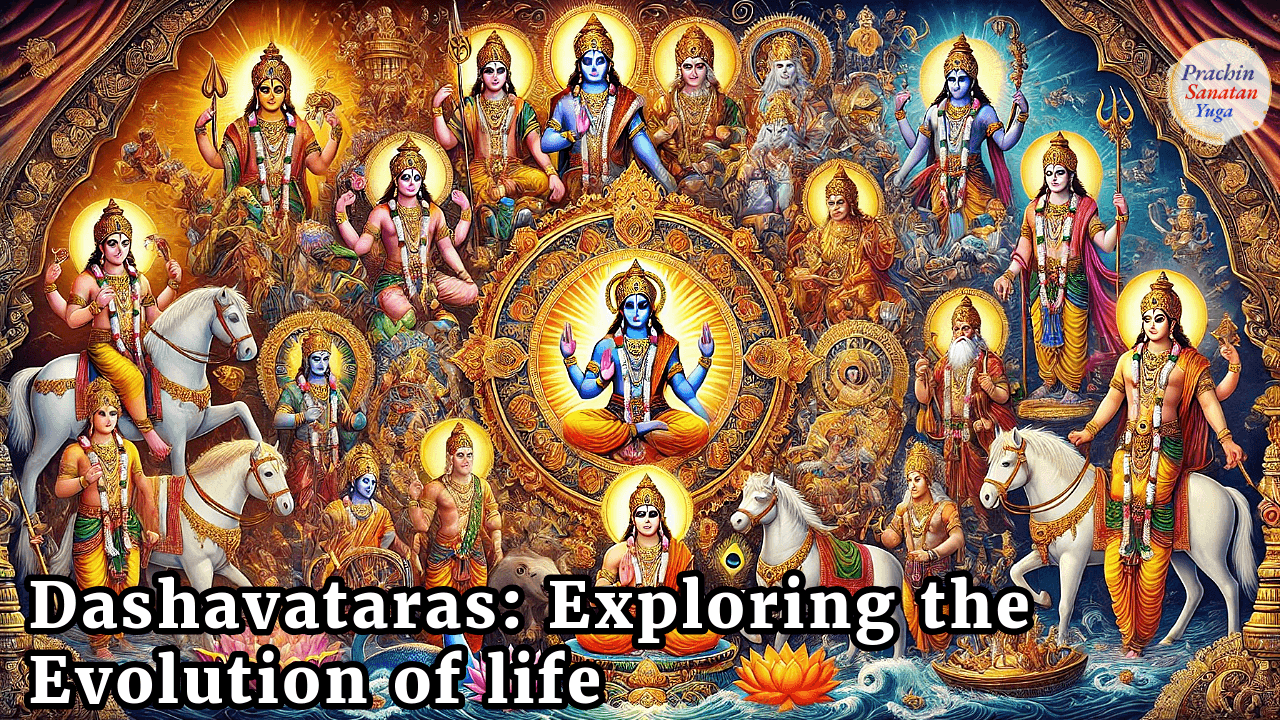
Dashavataras: Exploring the Evolution of life
Exploring the Divine Significance of 10 Avatars
The ten incarnations of Lord Vishnu, known as the Dashavataras, are an integral part of Sanatan Dharma and are held in high regard for their profound spiritual, philosophical, and cultural significance. Divine interventions by Lord Vishnu to restore dharma (righteousness) and protect creation whenever it is threatened by chaos and evil are exemplified by these avatars.
The evolution of life and cosmic order is symbolized by the Dashavataras, reflecting a deeper connection between spirituality and the natural progression of existence.
1. Matsya Avatar (The Fish)
The first avatar, Matsya, is symbolic of the primal beginnings of life in water. In this form, the Vedas are rescued and humanity is saved from a deluge by Vishnu, representing the protection of knowledge and the importance of divine guidance in times of crisis.
2. Kurma Avatar (The Tortoise)
Kurma, the tortoise, symbolizes stability and support as Vishnu assumes this form during the churning of the ocean (Samudra Manthan) to stabilize Mount Mandara. This form teaches us the importance of patience and perseverance in achieving goals, highlighting the essential need for balance and cooperation in life. In this role, Kurma showcases the significance of working together and maintaining a steady foundation in order to overcome challenges and reach our objectives.
3. Varaha Avatar (The Boar)
Varaha, the boar, actively retrieves the submerged Earth from the depths of the cosmic ocean, symbolizing the restoration of order. This avatar symbolizes the divine effort to overcome ignorance and destruction, ensuring the Earth’s survival.
4. Narasimha Avatar (The Man-Lion)
Vishnu’s power to transcend limitations and uphold justice is showcased by Narasimha, a half-man, half-lion form. This avatar provides divine protection for devotees and ensures the destruction of tyrannical forces, serving as a reminder that dharma triumphs over adharma.
5. Vamana Avatar (The Dwarf)
Vamana, the dwarf Brahmin, embodies humility and wisdom. He uses his intelligence and divine grace to subdue King Bali, highlighting the triumph of righteousness over ego and greed. Vamana shows that even the smallest actions rooted in dharma can lead to great accomplishments.
6. Parashurama Avatar (The Warrior Sage)
Parashurama actively embodies and enforces divine wrath against arrogance and oppression. He actively eradicates corrupt kshatriyas to actively cleanse society, symbolizing and actively demonstrating the need for justice and discipline to actively preserve balance in the social order.
7. Shree Rama Avatar (The Ideal King)
The life of Rama, the prince of Ayodhya, is epitomized by virtue, righteousness, and adherence to dharma in the Ramayana. His life as an ideal son, husband, and king is narrated, offering timeless lessons on morality, duty, and compassion.
8. Shree Krishna Avatar (The Divine Statesman)
The Mahabharata and the Bhagavad Gita have Krishna, a multifaceted avatar, as their central figure. Divine love, wisdom, and the essence of devotion (bhakti) are embodied by him. The teachings in the Gita, given by Krishna, highlight the importance of selfless action, surrender, and detachment.
9. Buddha Avatar (The Enlightened One)
Buddha, considered an avatar in many Hindu traditions, represents the path of compassion, non-violence, and enlightenment. His teachings address the suffering of life and guide humanity toward liberation (moksha) through mindfulness and morality.
10. Kalki Avatar (The Future Warrior)
The prophesied avatar, Kalki, is yet to be appeared. It is expected that he will be arrived on a white horse at the end of Kali Yuga to eradicate evil and restore dharma, symbolizing hope and renewal in times of despair.
“Philosophical and Evolutionary Interpretation”
The Dashavataras can also be interpreted as a metaphor for the evolutionary journey of life. The progression of creation is reflected by the avatars, from aquatic life (Matsya) to amphibians (Kurma), terrestrial animals (Varaha), half-animal forms (Narasimha), and eventually humans (Vamana, Parashurama, and beyond. The concept of cosmic evolution is aligned with by the avatars, bridging spiritual truths with scientific insights.
Table of Contents
“Relevance in Modern Times“
The Dashavataras continue to offer timeless lessons that hold relevance in today’s world. Each avatar actively addresses universal themes such as protecting the environment (Matsya, Varaha), upholding justice (Narasimha, Rama), and promoting peace (Buddha). They actively inspire us to act selflessly, actively preserve harmony, and actively contribute to societal welfare.
Considering all this,
The Dashavataras of Vishnu remind us profoundly of the divine’s commitment to preserving dharma and guiding humanity. Lord Vishnu assures us of his presence in our lives and his promise to protect the cosmic balance through these incarnations. The inspiring stories of these avatars continue to inspire faith, wisdom, and a deeper understanding of the eternal principles of Sanatan Dharma.
Exploring the Divine Significance of 10 Avatars Exploring the Divine Significance of 10 Avatars Exploring the Divine Significance of 10 Avatars Exploring the Divine Significance of 10 Avatars Exploring the Divine Significance of 10 Avatars Exploring the Divine Significance of 10 Avatars Exploring the Divine Significance of 10 Avatars Exploring the Divine Significance of 10 Avatars
